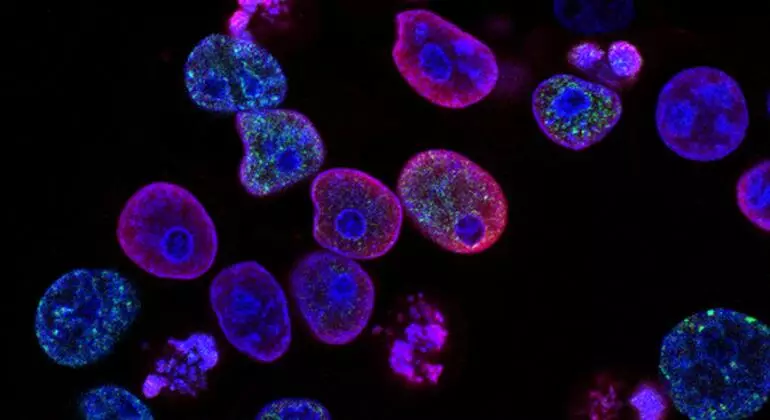Acute lymphoblastic leukemia (ALL) is a type of cancer that affects white blood cells in the body; it is the most common type of childhood cancer. The disease is characterized by an excessive proliferation of lymphoblasts, or immature white blood cells, which can rapidly build up in the bloodstream, crowding out normal cells. When this build-up happens, it suppresses the body’s ability to function properly and fight infection. Treatment for ALL typically involves combinations of chemotherapy, radiation, and stem cell transplantation to attack and eradicate the cancerous cells.
Table of Contents
What is Acute lymphoblastic leukemia
Acute lymphoblastic leukemia (ALL) is a type of cancer of the blood and bone marrow in which immature lymphocytes and other white blood cells are produced in the body in abnormally large amounts. This excess of cancerous white blood cells overwhelms and impairs the body’s healthy immune system, causing the affected person to become sick and require treatment. ALL is one of the most common types of childhood cancer and is seen most often in children and young adults who have not yet reached the age of 18. With appropriate treatments, which are tailored to the age and medical condition of the patient, the disease is often curable, but if left untreated, it can be deadly.
It is the most common type of childhood leukemia and one of the most common cancers in children and adults. With advances in treatment and care, the long-term survival rate for ALL is improving, with more patients relying on prolonged remission.
Symptoms
Acute lymphoblastic leukemia (ALL) is a form of blood cancer, that affects both children and adults. It is caused by the rapid division of damaged white blood cells. People affected by ALL experience symptoms such as fatigue, anemia, infections, and bleeding. If untreated, ALL can be life-threatening and requires immediate medical attention and treatment that may include chemotherapy, radiation, or a bone marrow transplant.
Acute lymphoblastic leukemia (ALL) is a type of cancer that affects the white blood cells, specifically the lymphocytes. Symptoms of ALL can include:
Feeling tired or weak
Shortness of breath
Easy bruising or bleeding
Fever or chills
Frequent infections
Swelling of the lymph nodes in the neck, underarm, or groin
Weight loss
Loss of appetite
Feeling full after eating only a small amount of food
Pain in the bones or joints
Painless lumps in the neck, underarms, stomach, or groin
If you or someone you know is experiencing any of these symptoms, it is important to contact a doctor or healthcare provider right away. Only a medical professional can properly diagnose and treat ALL.
Causes of Acute lymphoblastic leukemia
The exact cause of acute lymphoblastic leukemia (ALL) is not known. However, there are several factors that may increase a person’s risk of developing the disease. These include
Being exposed to high levels of radiation
Having a family history of ALL or other blood disorders
Having certain genetic disorders, such as Down syndrome or Klinefelter syndrome
Being exposed to certain chemicals, such as benzene
Having a weakened immune system due to HIV/AIDS or other conditions
It’s important to note that having one or more of these risk factors does not mean that a person will definitely develop ALL. Many people with these risk factors never develop the disease, and some people develop ALL without having any known risk factors.
Treatment
The treatment for acute lymphoblastic leukemia (ALL) will depend on several factors, including the person’s age, overall health, and the specific type and stage of cancer. In general, the main goal of treatment is to kill cancer cells and prevent them from spreading. This may involve one or more of the following treatments:
Chemotherapy: This is the main treatment for ALL, and it involves using medications to kill cancer cells. Chemotherapy is typically given in cycles, with each cycle consisting of several doses of medication over a specific period of time, followed by a rest period to allow the body to recover.
Radiotherapy: This treatment uses high-energy rays, such as X-rays, to kill cancer cells. It is usually given to specific areas of the body, such as the brain and spinal cord, to help control cancer.
Stem cell transplant: In some cases, a stem cell transplant may be used to replace the person’s diseased bone marrow with healthy bone marrow. This procedure is often used after chemotherapy to help the body produce healthy blood cells.
Biological therapy: This type of treatment uses medications or other substances to boost the body’s natural defenses against cancer. It may be used in combination with other treatments to help the body fight cancer.
In addition to these treatments, a person with ALL may also receive medications to manage their symptoms and side effects, such as painkillers, anti-nausea drugs, and blood transfusions. The treatment plan for ALL will be tailored to the individual and may involve a combination of different treatments.
Conclusion
Acute lymphoblastic leukemia (ALL) is a type of cancer that occurs in the bone marrow, where white blood cells are created. It is a type of leukemia or cancer of the lymphocytes, and it is one of the most common childhood cancers. When left untreated, ALL can spread to other tissues and organs, leading to a life-threatening illness. In most cases, treatment is successful and can lead to a long, healthy life for those with ALL.
